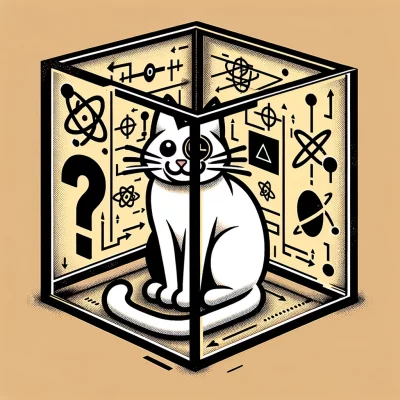Schrödinger’s Cat
What is Schrödinger’s Cat?
Schrödinger’s Cat is a famous idea that comes from the world of physics, a branch of science that deals with matter, energy, and the way they act on each other. Think about a cat that is inside a sealed box with a setup that can release poison based on a random event. Because we can’t see inside the box, we don’t know if the cat is alive or dead. The weird part? Until we open the box and check, the cat is thought to be both alive and dead at the same time. This idea was made to show the strange nature of the tiny particles that make up everything around us. It’s like a story that physicists tell to explain something really complex about how these small particles behave differently when they are not being watched.
The cat’s curious situation is tied to the behavior of teeny-tiny bits of matter, smaller than atoms, which make up everything in the universe. These small parts can exist in many states at once, a situation known as quantum superposition. By connecting the cat’s fate to whether a single atom falls apart or not, Schrödinger was pointing out how bizarre and hard to believe quantum mechanics can be when you try to apply it to everyday things, like a cat in a box.


Key Arguments
- Superposition: The idea is that the cat is a metaphor for the principle of superposition in physics. It shows how difficult and strange the concept can be when we try to apply it to things we can actually see and touch.
- Observation: A huge point of debate is about what counts as an observation. This part of the argument dives into whether things change just because we look at them and who or what needs to do the looking.
- Classical vs Quantum: This argument is about whether the rules for really small things like atoms also apply to big things like cats or baseballs, which normally follow the laws of physics we see and understand in daily life.
- Alternate Interpretations: Here, the discussion continues to think about different ways to understand quantum mechanics. These interpretations take different views on how things work in our universe at the smallest level.
Answer or Resolution
Up until now, the puzzle of Schrödinger’s Cat hasn’t been solved. It still stands as an example of the odd and confusing nature of quantum mechanics. Different ways of understanding quantum mechanics introduce various explanations. Some of these alternate ideas include the universe splitting into different versions every time something could happen in more than one way, or the idea that quantum mechanics doesn’t kick in unless we’re talking about very large groups of tiny particles. Decoherence is another explanation that suggests that as systems rub up against their surroundings, the weird superposition breaks down, preventing things like a cat from being both dead and alive.
Practical Applications
- Quantum Computing: Quantum computers use elements called qubits, which can be in multiple states at once. Playing with these states is super important for these computers to work better than regular ones.
- Quantum Cryptography: This kind of coding uses quantum concepts to keep information safe in a way that someone trying to sneak a peek would automatically be spotted because they’d change the system.
- Quantum Theory Development: Pondering over this thought experiment keeps pushing quantum mechanics forward, helping scientists understand more and maybe even discover new ways to use it.
Why is it Important
The tale of Schrödinger’s Cat isn’t just a fun riddle; it’s a cornerstone in thinking about the fundamentals of our world. For the average person, it gives a peek into the weird world of quantum mechanics where the usual rules don’t apply. It’s important because it stretches our minds to think about realities where things can exist in multiple states and challenges the way we see our day-to-day world. Understanding this can spark innovations in technology, such as computers that solve problems faster than we ever thought possible, or creating secure communication channels that can’t easily be hacked.
Related Topics
- Quantum Entanglement: This is another strange idea in physics where two particles, no matter how far apart they are in the universe, seem to be linked together. Whatever happens to one instantly affects the other.
- Heisenberg’s Uncertainty Principle: This principle declares that we can never know both the position and speed of a particle at the same time. The more precisely we know one, the less we know about the other.
- Wave-Particle Duality: This is the concept that tiny pieces of matter like electrons can act both like waves and like particles, which again shakes up our usual understanding of how things should behave.
Conclusion
In sum, Schrödinger’s Cat is a powerful symbol of the riddles at the heart of quantum physics. It challenges our typical understanding and stretches our imagination to its limits. It’s a thought experiment that doesn’t just live in textbooks and lectures but reaches into the tools and technologies we might use in the near future, changing the way we live and interact with the world. As for the cat, alive or dead, Schrödinger’s Cat will forever remind us that our quest for knowledge is full of surprises and that the search for understanding never truly ends.
Related Post
Recent Posts
William Faulkner
Intro William Faulkner was a novelist from Mississippi and a major figure in American literature.…
Euripides
Intro Euripides was a playwright who lived during the golden age of Athenian culture. He…
Epicurious
Intro Greek philosophy has given us a lot of easily misunderstood terms: words like hedonism,…
Ralph Waldo Emerson
Intro Ralph Waldo Emerson was one of the titans of American Romanticism. Obsessed with freedom,…
John Dewey
Intro Although his name isn’t well known, John Dewey had a deep impact on American…
Dante Alighieri
Intro Dante Alighieri was an Italian poet and philosopher of the 14th century. He is…